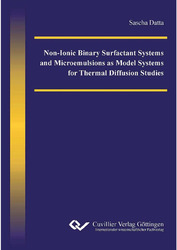| Fachbereiche | |
|---|---|
| Buchreihen (96) |
1378
|
| Nachhaltigkeit |
3
|
| Gesundheitswesen |
1
|
| Geisteswissenschaften |
2363
|
| Naturwissenschaften |
5406
|
| Mathematik | 229 |
| Informatik | 319 |
| Physik | 980 |
| Chemie | 1363 |
| Geowissenschaften | 131 |
| Humanmedizin | 243 |
| Zahn-, Mund- und Kieferheilkunde | 10 |
| Veterinärmedizin | 108 |
| Pharmazie | 147 |
| Biologie | 835 |
| Biochemie, Molekularbiologie, Gentechnologie | 121 |
| Biophysik | 25 |
| Ernährungs- und Haushaltswissenschaften | 45 |
| Land- und Agrarwissenschaften | 1004 |
| Forstwissenschaften | 201 |
| Gartenbauwissenschaft | 20 |
| Umweltforschung, Ökologie und Landespflege | 148 |
| Ingenieurwissenschaften |
1791
|
| Allgemein |
98
|
|
Leitlinien Unfallchirurgie
5. Auflage bestellen |
|
Erweiterte Suche
Non-Ionic Binary Surfactant Systems and Microemulsions as Model Systems for Thermal Diffusion Studies
Sascha Datta (Autor)Vorschau
Inhaltsverzeichnis, Datei (60 KB)
Leseprobe, Datei (82 KB)
Thermal diffusion (or the Soret effect) describes the diffusion of matter in the presence of a
temperature gradient. Although this process is studied and applied since more than 100 years the
underlying molecular mechanism in liquids is still far from being understood. Colloidal
dispersions are versatile model systems to study the thermal diffusion behavior of large particles
in a solvent. However, the synthesis of colloidal particles with identical morphology is a
complex task. On the other hand aqueous surfactant solutions and microemulsions are promising
systems to study the Soret effect. Compared to colloidal particles the aggregates form
spontaneously and do not require any additional stabilisation. Furthermore the radius and the
shape of the diffusing aggregates, as well as their interfacial tension can be systematically
adjusted via the variation of the composition and temperature. In order to address some
important aspects of the thermal diffusion behavior three different types of self-assembled
surfactant systems were formulated and systematically studied: (i) At first the role of the ionic
dye Basantol® Yellow 215, which causes an unexpected two-mode signal in the classical
Thermal Diffusion Forced Rayleigh Scattering (TDFRS) experiment [Ning et al. Progr Colloid
Polym Sci (2006) 133: 111–115], is examined using the system H2O – C12E6. Systematic phase
behavior studies and small angle neutron scattering experiments (SANS) proved that the dye is
incorporated into the aggregates like an ionic co-surfactant, influencing not only the thermal
diffusion behavior but also the overall properties of the systems. These results strongly suggest
that one should refrain from the use of surface-active dyes in TDFRS experiments on
self-assembled systems. (ii) To study the dependence of the Soret coefficient ST on the radius of
the aggregates and the slope of the interfacial tension, both being controversially discussed in the
literature, different microemulsions of the type H2O – C12E5 –n-alkane were formulated that
allow for an isothermal study of these dependencies. Correlating the results of the systematic
SANS and interfacial tension measurements with the Soret coefficient ST it was found that within
the measurement range ST depends almost linearly on the droplet radius, the slope of the
interfacial tension as well as on the product of both quantities. (iii) In the last part systematic
surface tension and TDFRS measurements were performed in binary aqueous n-alkyl glucoside
(CiGj) solutions to study the thermal diffusion behavior around the critical micelle concentration
(cmc). The obtained results clearly show that the Soret coefficient exhibits an abrupt change at
the cmc. To sum up, this work shows that aqueous surfactant systems and microemulsions are
eminently suited to elucidate some of the underlying molecular mechanism of the Soret effect.
| ISBN-13 (Printausgabe) | 3869559713 |
| ISBN-13 (Printausgabe) | 9783869559711 |
| ISBN-13 (E-Book) | 9783736939714 |
| Buchendformat | A5 |
| Sprache | Englisch |
| Seitenanzahl | 209 |
| Umschlagkaschierung | matt |
| Auflage | 1 Aufl. |
| Band | 0 |
| Erscheinungsort | Göttingen |
| Promotionsort | Köln |
| Erscheinungsdatum | 20.12.2011 |
| Allgemeine Einordnung | Dissertation |
| Fachbereiche |
Chemie
|








